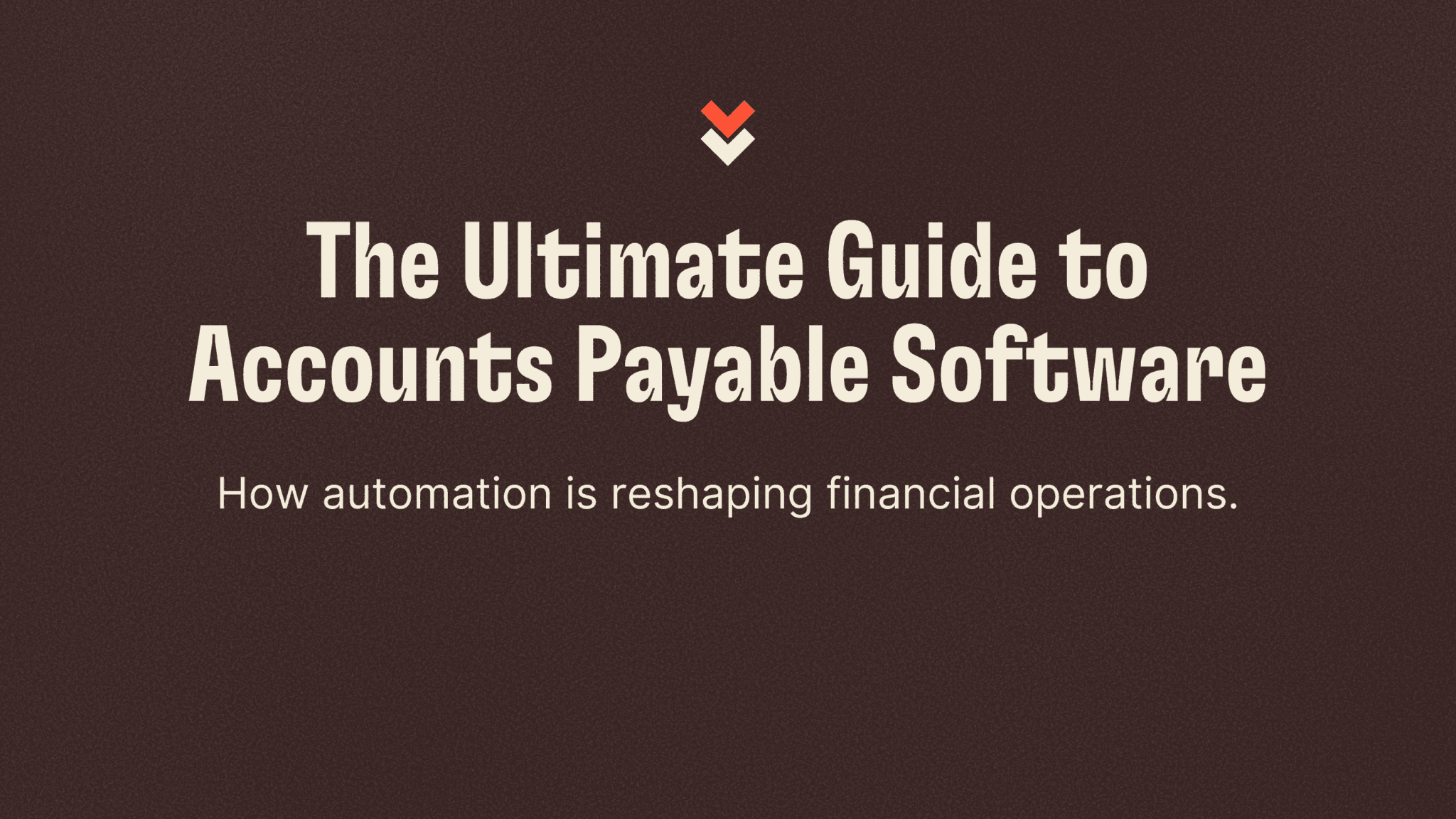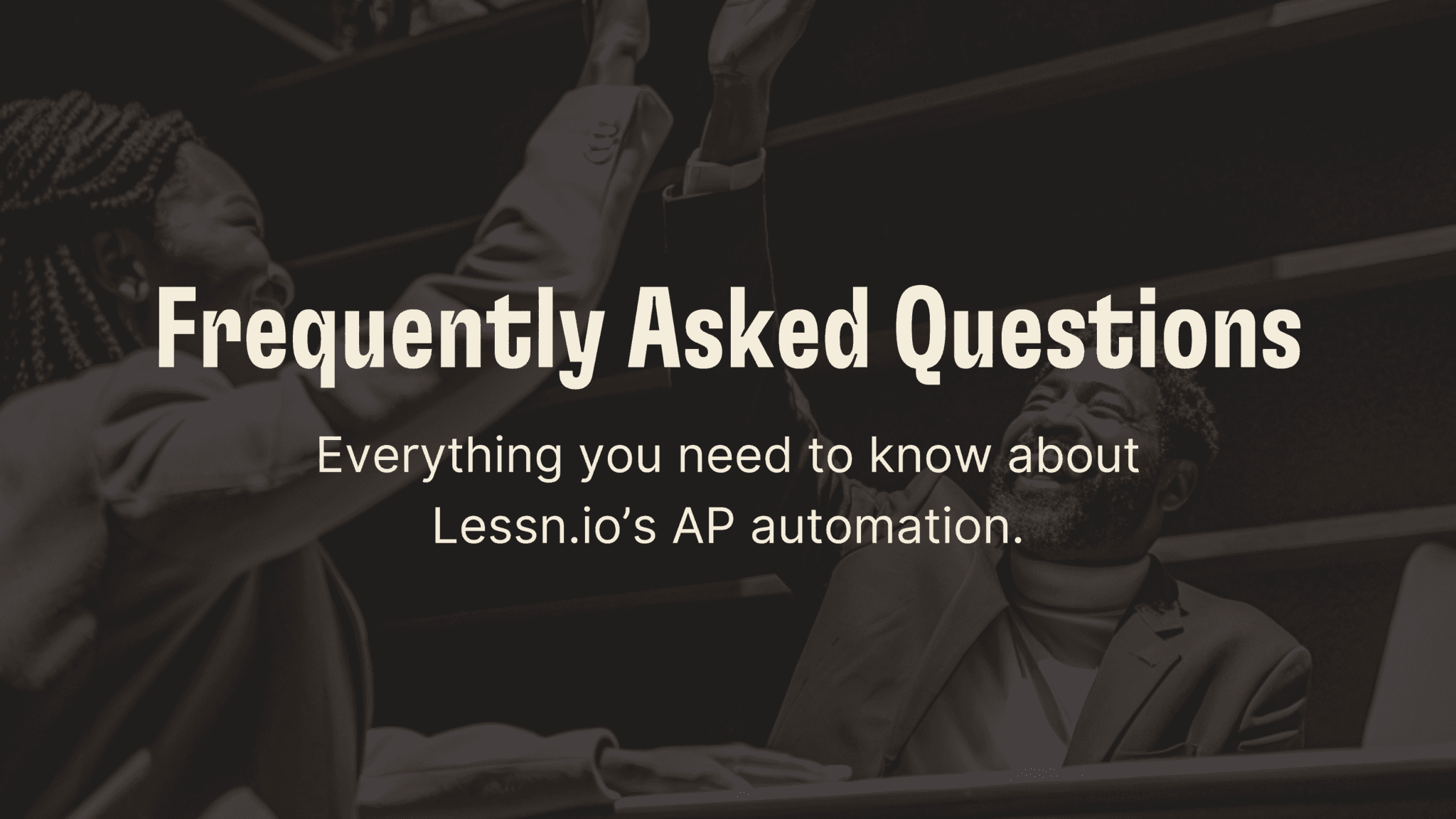Accounts Payable Software That Streamlines & Pays You Back
Apr 4, 2025
Lessn.io’s intelligent accounts payable software automates workflows, maximises rewards, and integrates seamlessly with your existing systems. Book a Demo Cut AP Processing...
Lessn.io’s intelligent accounts payable software automates workflows, maximises rewards, and integrates seamlessly with your existing systems.
Cut AP Processing Time by 75% & Reduce Payment Errors by 90%
Managing accounts payable (AP) manually is time-consuming, prone to errors, and limits financial visibility. Lessn.io’s accounts payable software simplifies the process, reducing invoice processing time by up to 75% and cutting down manual payment errors by 90%.
By automating invoice handling, approval workflows, and payment execution, businesses gain better control over cash flow, reduce costs, and eliminate late payments.

Why Businesses Struggle with AP Management
Accounts payable plays a crucial role in business finance, but many companies face significant challenges that slow down operations and increase costs.
Key AP Challenges That Impact Business Growth
1. Disconnected Systems Create Data Silos
Many businesses rely on multiple, unconnected systems for invoicing, payments, and reconciliation. Without a centralised AP platform, finance teams spend hours manually transferring data, increasing the risk of errors, mismatched records, and duplicate payments.
2. Lack of Real-Time Cash Flow Visibility
Without instant access to payables data, finance teams struggle with forecasting. Poor visibility into outstanding invoices and payment schedulesoften results in cash flow mismanagement and unnecessary borrowing.
3. Slow Invoice Approvals & Payment Processing
Manual approval workflows require constant follow-ups and email reminders, causing payment delays that lead to late fees and missed supplier deadlines. This inefficiency strains vendor relationships and can lead to tighter payment terms or increased costs.
4. Missed Cost-Saving Opportunities
Businesses often lose out on early payment discounts, cashback incentives, and credit card rewards due to inefficient AP processes. Strategic payment timing—which is impossible with manual processes—can unlock significant financial benefits.
Manual vs. Automated AP Workflows: A Comparison

By automating AP, businesses eliminate delays, improve financial accuracy, and maximise rewards—giving them a competitive edge.
The Ultimate Guide to Accounts Payable Software

The Role of AP Software in Modern Finance
Accounts payable software is more than just a tool—it’s a strategic asset that transforms finance operations. Businesses can move from slow, error-prone processes to automated, real-time workflows that optimise cash flow and reduce risk.
How AP Software Transforms Business Finance
Eliminates manual data entry with AI-powered invoice capture
Accelerates approvals with rule-based workflows
Reduces human errors with automated payment execution
Enhances financial visibility through real-time reporting
Strengthens security with fraud detection and compliance tracking
The Evolution from Paper-Based Systems to AI-Driven Automation
Traditional AP processes involved paper invoices, manual approvals, and spreadsheets—leading to inefficiencies. Cloud-based and AI-powered solutions like Lessn.io now offer:
End-to-end automation, reducing manual intervention
Seamless integrations with accounting and ERP systems
Mobile accessibility, allowing invoice approvals on the go
Data-driven insights, enabling proactive financial decisions

The AP Software Landscape: Choosing the Right Solution
Not all AP software is the same. The right solution depends on business size, complexity, and integration needs.
Types of AP Software: Finding the Right Fit
1. Standalone AP Solutions (Ideal for Small Businesses)
Standalone AP solutions are ideal for small businesses that need efficient invoice management and payment automation without the complexity of an enterprise resource planning (ERP) system.
These solutions focus on streamlining vendor payments and often integrate with cloud-based accounting tools like Xero, MYOB, and QuickBooks.
By using a standalone AP solution, businesses can reduce manual work, automate repetitive tasks, and ensure timely payments without requiring an in-house IT team to manage a full-scale ERP system.
2. ERP-Integrated AP Software (For Mid-to-Large Enterprises)
For mid-to-large enterprises, ERP-integrated AP software is often the preferred choice. These platforms are built directly into enterprise resource planning (ERP) systems such as SAP, NetSuite, or Microsoft Dynamics, allowing companies to manage multi-location, multi-currency, and high-volume transactionsseamlessly.
Large organisations handling global supplier networks require robust AP systems that can track invoices, approvals, and payments in multiple currencies, ensuring that all transactions comply with tax regulations and financial reporting requirements.
3. Cloud-Based AP Platforms (Scalable & Remote-Friendly)
Cloud-based AP platforms offer a scalable, flexible solution for businesses of all sizes, particularly those that operate remotely or require real-time access to financial data.
These platforms allow finance teams to approve invoices, schedule payments, and monitor cash flow from anywhere, ensuring business continuity even when teams are working across different locations.
Unlike traditional on-premise AP software, cloud-based solutions connect seamlessly with banking systems, accounting software, and ERPs, eliminating the need for manual reconciliation and improving overall financial efficiency.
The Evolution of AP Software: From Basic Digitisation to AI-Powered Automation
Accounts payable (AP) software has evolved significantly over the past decade, shifting from basic invoice digitisation to advanced AI-driven automation. This transformation has enabled businesses to eliminate manual inefficiencies, reduce financial risks, and improve operational control.
Key Trends Shaping AP Automation
1. AI & Machine Learning for Invoice Processing
Artificial intelligence (AI) and machine learning have introduced a new level of intelligence in invoice processing.
AP software can now automatically extract, classify, and validate invoice data, reducing the need for human intervention. Businesses that implement AI-powered AP solutions experience fewer duplicate invoices, fewer overpayments, and significantly reduced processing times.
Machine learning algorithms continuously improve, allowing the system to detect anomalies, flag potential fraud, and suggest optimal payment schedules.
2. Cloud-Based Accessibility & Mobile-First Solutions
Cloud-based accessibility has also transformed AP automation by enabling remote invoice approvals, mobile-friendly workflows, and real-time reporting. With businesses becoming increasingly global and decentralised, AP teams must be able to access financial data on any device, from any location.
Cloud-based AP platforms provide seamless integration with existing systems, allowing companies to automate reconciliations, generate real-time financial reports, and monitor payables in a centralised dashboard.
3. Automated Supplier Collaboration
Another key advancement in AP automation is the rise of automated supplier collaboration portals. Businesses can now provide vendors with direct access to upload invoices, track payment statuses, and receive automated payment confirmations.
This level of transparency improves supplier relationships, reduces the number of payment-related inquiries, and ensures that businesses stay compliant with contractual payment terms.
Core Functionalities: The Heart of AP Software
A high-performing AP system must offer more than just basic invoice processing—it should include intelligent features that enhance efficiency, improve financial decision-making, and reduce payment risks.
1. Vendor Management & Collaboration
Vendor management and collaboration are fundamental components of an effective AP system. A centralised vendor database ensures that finance teams can store, track, and manage all supplier records in one place, eliminating the need for spreadsheets and manual data entry.
Automated vendor onboarding processes help companies verify supplier credentials, maintain compliance records, and track contract terms, reducing the risk of engaging with non-compliant vendors.
2. Smart Payment Execution
Smart payment execution is another critical functionality of modern AP automation. By using rule-based workflows, businesses can schedule payments based on due dates, cash flow forecasts, and supplier preferences.
Companies can also choose from multiple payment options, including credit cards, bank transfers, and virtual payment methods, optimising payment timing while taking advantage of cashback, rebates, and rewards programs.
3. Real-Time Financial Reporting
Real-time financial reporting enables businesses to gain full visibility into outstanding invoices, approvals, and payments, allowing finance teams to track expenses, identify trends, and prevent cash flow shortages.
Instead of relying on static, outdated financial reports, AP automation software provides live dashboards with actionable insights, helping businesses make data-driven decisions and plan ahead.
4. Compliance & Audit Support
Compliance and audit support is another crucial feature of AP software, particularly for businesses operating in regulated industries.
Automated AP solutions maintain detailed audit trails for every transaction, ensuring that all payments follow predefined approval workflows and security protocols.
Multi-level approval structures reduce fraud risks, enforce financial controls, and ensure regulatory compliance, helping businesses avoid costly penaltiesassociated with non-compliance.
Seamless Integrations: Connecting AP with Your Financial Ecosystem
An AP solution should integrate seamlessly with the existing financial tools and systems within a business, allowing for automated data synchronisation, streamlined reporting, and improved workflow efficiency.
1. ERP System Integrations
For companies using ERP systems like NetSuite, SAP, or Microsoft Dynamics, AP software must be able to sync seamlessly with these platforms, ensuring that invoice approvals, payments, and reconciliations are automatically updated in real time.
Without this integration, finance teams waste hours manually entering data, increasing the risk of errors and inconsistencies in financial reports.
2. Accounting Software Compatibility
Accounting software compatibility is equally important, as most businesses use Xero, MYOB, or QuickBooks to manage their financial records.
Integrating AP automation software with accounting platforms eliminates the need for manual reconciliations, reduces discrepancies, and ensures accurate financial reporting.
With an integrated system, finance teams can process invoices, schedule payments, and update their ledgers in real time, maintaining accurate and up-to-date records.
3. Banking System & Payment Gateway Connections
Banking system and payment gateway connections provide secure, automated transaction processing, eliminating the need for businesses to manually log into multiple banking portals to execute payments.
By integrating directly with business bank accounts and payment processors, AP automation ensures that funds are transferred securely, on time, and with minimal manual intervention.
Businesses can also track payment statuses instantly, improving cash flow forecasting and financial planning.
The Future of AP Software: AI, Blockchain, and Beyond
As businesses continue to prioritise efficiency and cost reduction, AP automation will evolve even further. Artificial intelligence will play an increasingly significant role in AP automation, improving invoice recognition, fraud detection, and anomaly detection.
AI-powered algorithms will be able to predict optimal payment times, detect potential duplicate invoices, and recommend cost-saving strategies in real time.
Blockchain technology is also set to revolutionise AP automation, particularly in industries that require high levels of transaction security and transparency.
By leveraging smart contracts and decentralised ledgers, businesses can reduce the risk of payment fraud, eliminate manual verification steps, and create tamper-proof financial records.
Another emerging trend is predictive analytics in AP management, where AI-driven insights will help companies forecast cash flow, identify potential financial risks, and optimise payment schedules.
Businesses that adopt predictive analytics will be able to proactively manage their financial health, ensuring they maintain liquidity while maximising cost-saving opportunities.
Ultimately, the future of AP automation is about leveraging technology to drive financial efficiency, increase security, and reduce human error.
Companies that embrace these advancements will gain a competitive edge, reducing operational costs, improving vendor relationships, and making smarter financial decisions.

Why Lessn.io is the Best AP Software for Your Business
Lessn.io provides an intelligent accounts payable solution that simplifies payments, maximises rewards, and improves financial visibility.
1. Fully Automated Workflows
Capture invoices, route approvals, and schedule payments seamlessly
2. Time & Cost Savings
Reduce processing time by 75% and cut errors by 90%
3. Optimised Payment Timing & Rewards
Pay vendors while earning cashback and credit card points
4. Seamless Integrations
Works with Xero, MYOB, QuickBooks, and major ERPs
5. Real-Time Insights
Monitor payables, control expenses, and forecast cash flow with live dashboards
FAQ: Answering Your AP Automation Questions

How does Lessn.io help businesses save time on AP?
Lessn.io automates invoice processing, approval routing, and payment execution, cutting processing time by 75%.
Can I earn rewards on payments with Lessn.io?
Yes, Lessn.io allows businesses to pay vendors using credit cards, unlocking cashback and AMEX points.
Does Lessn.io integrate with my accounting system?
Yes, Lessn.io integrates seamlessly with Xero, MYOB, QuickBooks, and major ERPs.
How does Lessn.io improve cash flow management?
By scheduling payments strategically and using credit card float periods, Lessn.io helps businesses manage liquidity more effectively.
Is Lessn.io secure?
Yes, Lessn.io uses bank-grade encryption and multi-level security controls to protect all transactions.
Save Time. Cut Costs. Get Paid Smarter.
AP automation is essential for businesses looking to streamline operations, reduce costs, and optimise cash flow.
Lessn.io offers a powerful, integrated solution that simplifies accounts payable while unlocking financial benefits.
Book a Demo to see how Lessn.io can transform your AP process.
Continue Reading
START REWARDING YOUR HARD WORK TODAY
Join Australian businesses turning payments into rewards.




